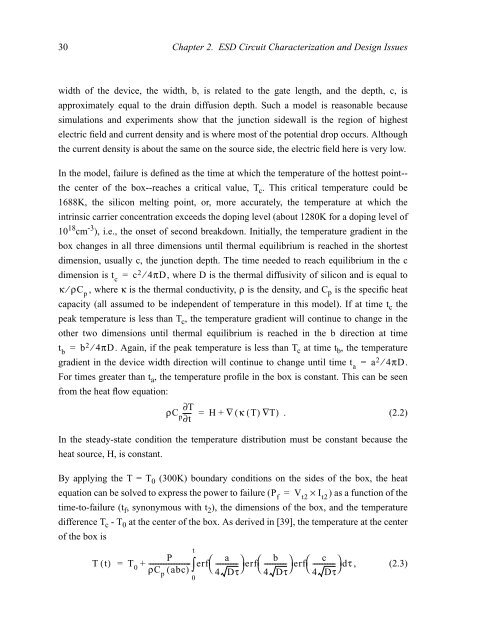characterization, modeling, and design of esd protection circuits
characterization, modeling, and design of esd protection circuits
characterization, modeling, and design of esd protection circuits
You also want an ePaper? Increase the reach of your titles
YUMPU automatically turns print PDFs into web optimized ePapers that Google loves.
30 Chapter 2. ESD Circuit Characterization <strong>and</strong> Design Issues<br />
width <strong>of</strong> the device, the width, b, is related to the gate length, <strong>and</strong> the depth, c, is<br />
approximately equal to the drain diffusion depth. Such a model is reasonable because<br />
simulations <strong>and</strong> experiments show that the junction sidewall is the region <strong>of</strong> highest<br />
electric field <strong>and</strong> current density <strong>and</strong> is where most <strong>of</strong> the potential drop occurs. Although<br />
the current density is about the same on the source side, the electric field here is very low.<br />
In the model, failure is defined as the time at which the temperature <strong>of</strong> the hottest pointthe<br />
center <strong>of</strong> the box--reaches a critical value, Tc . This critical temperature could be<br />
1688K, the silicon melting point, or, more accurately, the temperature at which the<br />
intrinsic carrier concentration exceeds the doping level (about 1280K for a doping level <strong>of</strong><br />
10 18 cm -3 ), i.e., the onset <strong>of</strong> second breakdown. Initially, the temperature gradient in the<br />
box changes in all three dimensions until thermal equilibrium is reached in the shortest<br />
dimension, usually c, the junction depth. The time needed to reach equilibrium in the c<br />
dimension is tc c , where D is the thermal diffusivity <strong>of</strong> silicon <strong>and</strong> is equal to<br />
, where κ is the thermal conductivity, ρ is the density, <strong>and</strong> Cp is the specific heat<br />
capacity (all assumed to be independent <strong>of</strong> temperature in this model). If at time tc the<br />
peak temperature is less than Tc , the temperature gradient will continue to change in the<br />
other two dimensions until thermal equilibrium is reached in the b direction at time<br />
. Again, if the peak temperature is less than Tc at time tb , the temperature<br />
gradient in the device width direction will continue to change until time .<br />
For times greater than ta , the temperature pr<strong>of</strong>ile in the box is constant. This can be seen<br />
from the heat flow equation:<br />
2 = ⁄ 4πD<br />
κ ⁄ ρCp tb b2 = ⁄ 4πD<br />
ta a2 = ⁄ 4πD<br />
∂T<br />
ρCp∂ t<br />
= H + ∇ ( κ ( T)<br />
∇T)<br />
. (2.2)<br />
In the steady-state condition the temperature distribution must be constant because the<br />
heat source, H, is constant.<br />
By applying the T = T0 (300K) boundary conditions on the sides <strong>of</strong> the box, the heat<br />
equation can be solved to express the power to failure ( Pf = Vt2 × It2) as a function <strong>of</strong> the<br />
time-to-failure (tf , synonymous with t2 ), the dimensions <strong>of</strong> the box, <strong>and</strong> the temperature<br />
difference Tc - T0 at the center <strong>of</strong> the box. As derived in [39], the temperature at the center<br />
<strong>of</strong> the box is<br />
t<br />
P<br />
T() t T0 ------------------------- erf⎛<br />
a<br />
-------------- ⎞erf⎛ b<br />
-------------- ⎞ c<br />
=<br />
+<br />
erf⎛--------------<br />
⎞ , (2.3)<br />
ρCp ( abc)<br />
∫<br />
dτ<br />
⎝4 Dτ⎠<br />
⎝4 Dτ⎠<br />
⎝4 Dτ⎠<br />
0
















